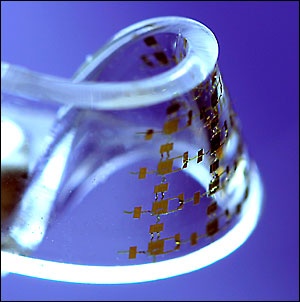Nov 20 2008
They've made electronics that can bend. They've made electronics
that can stretch.
 An optical image of an electronic device in a complex deformation mode.
An optical image of an electronic device in a complex deformation mode.
And now, they've reached the ultimate goal -- electronics that can be
subjected to any complex deformation, including twisting.
Yonggang Huang, Joseph Cummings Professor of Civil and Environmental Engineering
and Mechanical Engineering at Northwestern
University's McCormick School of Engineering and Applied Science, and John
Rogers, the Flory-Founder Chair Professor of Materials Science and Engineering
at the University of Illinois at Urbana-Champaign, have improved their so-called
“pop-up” technology to create circuits that can be twisted. Such
electronics could be used in places where flat, unbending electronics would
fail, like on the human body.
Their research will be published by the Proceedings of the National Academy
of Sciences (PNAS).
Electronic components historically have been flat and unbendable because silicon,
the principal component of all electronics, is brittle and inflexible. Any significant
bending or stretching renders an electronic device useless.
Huang and Rogers developed a method to fabricate stretchable electronics that
increases the stretching range (as much as 140 percent) and allows the user
to subject circuits to extreme twisting. This emerging technology promises new
flexible sensors, transmitters, new photovoltaic and microfluidic devices, and
other applications for medical and athletic use.
The partnership -- where Huang focuses on theory, and Rogers focuses on experiments
-- has been fruitful for the past several years. Back in 2005, the pair developed
a one-dimensional, stretchable form of single-crystal silicon that could be
stretched in one direction without altering its electrical properties; the results
were published by the journal Science in 2006. Earlier this year they made stretchable
integrated circuits, work also published in Science.
Next, the researchers developed a new kind of technology that allowed circuits
to be placed on a curved surface. That technology used an array of circuit elements
approximately 100 micrometers square that were connected by metal “pop-up
bridges.”
The circuit elements were so small that when placed on a curved surface, they
didn't bend -- similar to how buildings don't bend on the curved
Earth. The system worked because these elements were connected by metal wires
that popped up when bent or stretched. The research was the cover article in
Nature in early August.
In the research reported in PNAS, Huang and Rogers took their pop-up bridges
and made them into an “S” shape, which, in addition to bending and
stretching, have enough give that they can be twisted as well.
“For a lot of applications related to the human body -- like placing
a sensor on the body -- an electronic device needs not only to bend and stretch
but also to twist,” said Huang. “So we improved our pop-up technology
to accommodate this. Now it can accommodate any deformation.”
Huang and Rogers now are focusing their research on another important application
of this technology: solar panels. The pair published a cover article in Nature
Materials this month describing a new process of creating very thin silicon
solar cells that can be combined in flexible and transparent arrays.
Posted November 21st, 2008